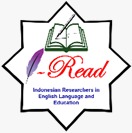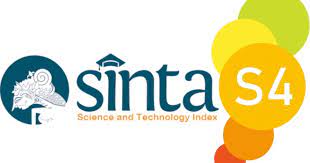A Study of EFL Students’ Perspective on Ambiguity Tolerance
DOI:
https://doi.org/10.22219/englie.v2i1.14858Abstract
This research aims to investigate the EFL students' perspective on ambiguity tolerance. The researcher used a descriptive qualitative approach for this research. To collect the data, the researcher used the Second Language Tolerance of Ambiguity Scale (SLTAS) as the instrument. This research involved 30 students of the 5th semester of Tidar University Magelang as the participant. The result shows that the participants have low ambiguity tolerance in the term reading and listening and more tolerance in speaking and writing.
Downloads
References
Alahdadi, S., & Ghanizadeh, A. (2017). Language Teaching Research The dynamic interplay among EFL learners ’ ambiguity tolerance , adaptability , cultural intelligence , learning approach , and language achievement. Iranian Journal of Language Teaching Research
Urmia, 5(1), 37–50. Astalin, P. K. (2013). Qualitative Reaserch Desaigns : A Conceptual Framework. 2(1), 118–124. Başöz, T. (2015). Exploring the relationship between tolerance of ambiguity of EFL learners and their vocabulary knowledge. 11(2), 53–66.
Brown, H. D. (2000). Principles of Language Learning (4th ed). Longman.
Chiang, H. (2016). A Study of Interactions among Ambiguity Tolerance , Classroom Work Styles , and English Proficiency. 9(6), 61–75. https://doi.org/10.5539/elt.v9n6p61
Dewaele, J.-M., & Li, W. (2013). Is multilingualism linked to a higher tolerance of ambiguity? 16, 231–240. https://doi.org/10.1017/S1366728912000570
Dewaele, J., & Ip, T. S. (2013). The link between Foreign Language Classroom Anxiety, Second Language Tolerance of Ambiguity and Self-rated English proficiency among Chinese learners. Studies in Second Language Learning and Teaching, 3(1), 47–66.
Erten, I. H., & Topkaya, E. Z. (2009). Understanding Tolerance of Ambiguity of EFL Learners in Reading Classes at Tertiary Level. Novitas-ROYAL, 3(1), 29–44.
Furnham, A., & Marks, J. (2013). Tolerance of Ambiguity : A Review of the Recent Literature. 4(9), 717–728. Genç, G. (2016). Can ambiguity tolerance , success in reading , and gender predict the foreign language reading anxiety ? Journal of Language and Linguistic Studies, 12(2), 135–151.
Kalman, M. (2020). “ It Requires Interest , Time , Patience and Struggle ”: Novice Researchers ’ Perspectives on and Experiences of the Qualitative Research Journey. Qualitative Research in Education, 8(3), 341–377. https://doi.org/10.17583/qre.2019.4483
Karbalaee, S., & Corresponding, K. (2012). An Analysis of the Associations between Ambiguity Tolerance and EFL Reading Strategy Awareness. English Language Teaching, 5(3), 188–196. https://doi.org/10.5539/elt.v5n3p188
Kimura, H. (2016). L2 Intolerance of ambiguity revisited : Toward a comprehensive understanding. 4(2), 197–216. https://doi.org/10.30438/ksj.2016.4.2.6
Kocaman, O., & Pamukoglue, M. (2018). Exploring the Perceptions of EFL Learners on Ambiguity Tolerance : Sakarya University Sample. 8, 224–233. https://doi.org/10.19126/suje.430219
Kung, F. (2018). Teaching and learning English as a foreign language in Taiwan : A socio-cultural analysis. August 2017.
M Ely, C. (1989). Tolerance of Ambiguity and Use of Second Language Strategies. Foreign Language Annalysis, 22(5), 437–445.
Magilvy, J. K., & Eileen, T. (2009). A First Qualitative Project : Qualitative Descriptive Design for Novice Researchers. JPSN, 14(4), 298–300. https://doi.org/10.1111/j.1744-6155.2009.00212.x
Nassaji, H. (2015). Qualitative and descriptive research : Data type versus data analysis. https://doi.org/10.1177/1362168815572747
Ngozwana, N. (2018). Ethical Dilemmas in Qualitative Research Methodology : Researcher ’ s Reflections. International Journal of Educational Methodology, 4(1), 19–28. https://doi.org/10.12973/ijem.4.1.19
Nosratinia, M., Niknam, M., & Sarabchian, E. (2013). The Role of Emotional Intelligence and Tolerance of Ambiguity in Predicting EFL Learners ’ Language Learning Strategies. 17(1), 22–29.
Rao, P. S. (2019). The role of english as a global language. Research Journal Of English (RJOE), 4(1), 65–79.
Reid, J. (1995). Learning styles in the ESL/EFL classroom. Heinle and Heinle publisher. Si, P. (2019). A Study of the Differences between EFL and ESL for English Classroom Teaching in China. 15(01), 32–35.
Sulistiyo, U., Wiryotinoyo, M., & Wulan, R. (2019). Examining an English as a Foreign Language Teacher Education Program (EFLTEP)’s Curriculum: A Case Study in an Indonesian University. European Journal of Educational Research, 8(4), 1323–1333. https://doi.org/10.12973/eu-jer.8.4.1323
Vahedi, V. S., & Fatemi, A. H. (2016). The Role of Emotional Intelligence and Tolerance of Ambiguity in Academic Iranian EFL Learners ’ Willingness to Communicate. 7(1), 178–184.
Weissenstein, A., Ligges, S., Brouwer, B., Marschall, B., & Friederichs, H. (2014). Measuring the ambiguity tolerance of medical students : a cross-sectional study from the first to sixth academic years. BMC Family Practice, 15(6), 1–5.
Downloads
Published
How to Cite
Issue
Section
License
Copyright (c) 2021 Kurniasari, F. A., & Indriani, L.

This work is licensed under a Creative Commons Attribution-ShareAlike 4.0 International License.
Authors who publish with English Learning Innovation (englie) agree to the following terms:
- For all articles published in English Learning Innovation (englie), copyright is retained by the authors. Authors give permission to the publisher to announce the work with conditions. When the manuscript is accepted for publication, the authors agree to automatic transfer of the publishing right to the publisher.
- Authors retain copyright and grant the journal right of first publication with the work simultaneously licensed under a Creative Commons Attribution-ShareAlike 4.0 International License that allows others to share the work with an acknowledgement of the work's authorship and initial publication in this journal.
- Authors are able to enter into separate, additional contractual arrangements for the non-exclusive distribution of the journal's published version of the work (e.g., post it to an institutional repository or publish it in a book), with an acknowledgment of its initial publication in this journal.
- Authors are permitted and encouraged to post their work online (e.g., in institutional repositories or on their website) prior to and during the submission process, as it can lead to productive exchanges, as well as earlier and greater citation of published work (See The Effect of Open Access).
This work is licensed under a Creative Commons Attribution-ShareAlike 4.0 International License.

















1.png)












